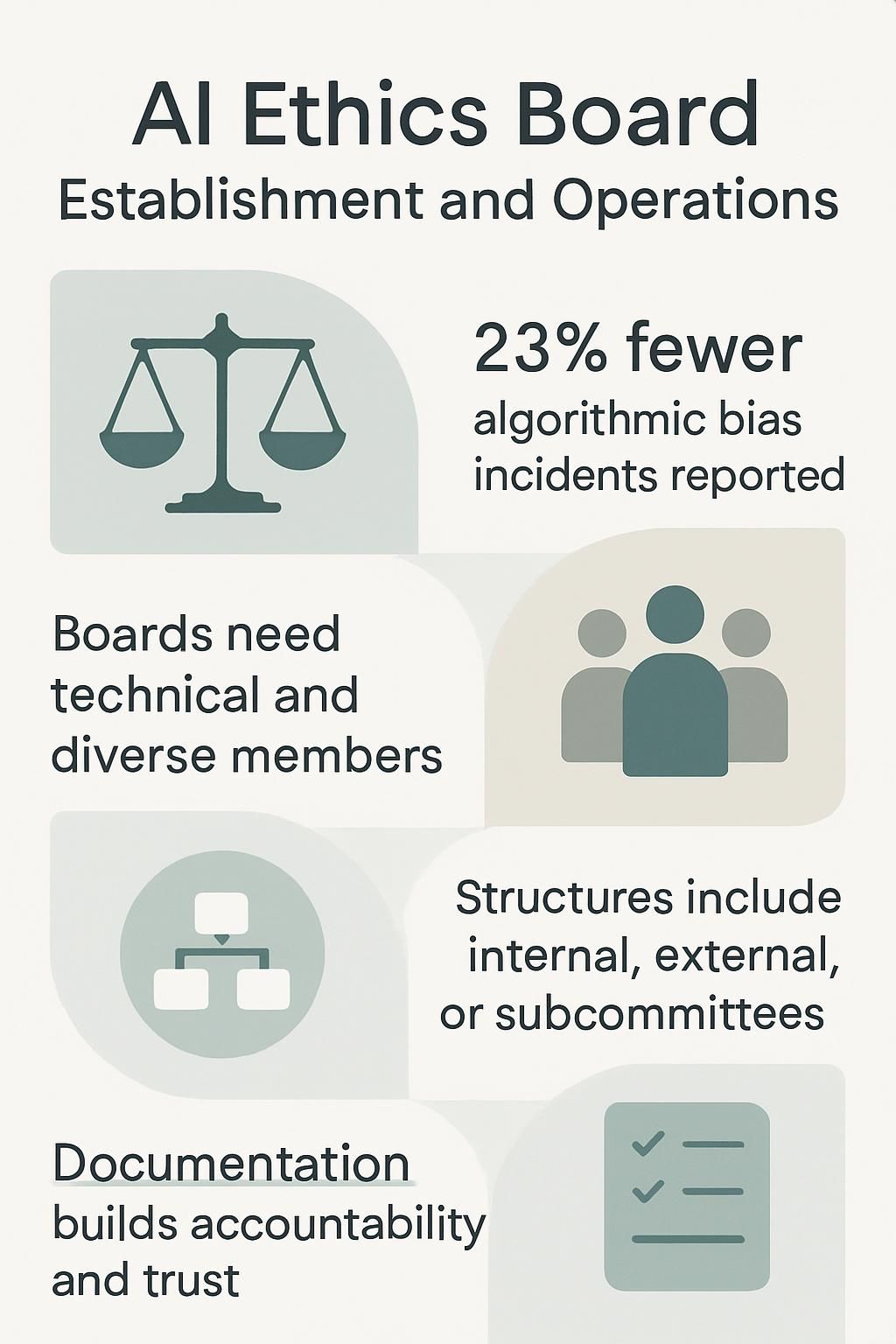AI Ethics Board Establishment and Operations


Understanding AI Integration

AI ethics boards serve as essential oversight mechanisms for responsible AI development within organizations. These committees review research, guide deployment, and address risks associated with artificial intelligence systems.
They help companies avoid ethical pitfalls while advancing in the AI field.
Reuben "Reu" Smith, founder of WorkflowGuide.com and AI automation strategist, emphasizes the importance of ethical oversight in AI development.
Statistics highlight the growing significance of these boards. While only 35% of companies currently have an AI governance framework, 87% plan to implement AI ethics policies by 2025.
Major tech companies like Meta, Microsoft, and Google DeepMind have established such boards to guide their AI research and product decisions.
These boards serve critical functions: advising leadership on research priorities, evaluating commercialization strategies, interpreting ethics principles, and mitigating significant risks.
Their decision-making processes require clear voting procedures, with different majority thresholds for routine versus critical decisions.
Proper funding for these boards is crucial. Axon provides $5,000 per year plus $5,000 per meeting for each member, while Meta's Oversight Board members earn six-figure salaries. This financial commitment reflects the importance of their work.
Effective boards require diverse membership across technical expertise, ethical insight, legal knowledge, gender, race, ethnicity, and geography. This diversity helps identify potential issues that homogeneous groups might overlook.
The remainder of this article will explore how to establish and operate an AI ethics board that is both effective and impactful. It will provide practical steps to maintain AI innovation while ensuring responsible development.
Key Takeaways
- Companies with formal AI ethics oversight experience 23% fewer incidents of algorithmic bias, making these boards essential for responsible AI development.
- Effective AI Ethics Boards need both technical experts and members with diverse backgrounds to catch blind spots that homogeneous teams often miss.
- Board structures can be internal (employees across departments), external (independent entities), or include specialized subcommittees for focused oversight of specific ethical issues.
- Member selection should prioritize technical AI expertise, ethical reasoning skills, legal knowledge, and professional integrity to ensure balanced decision-making.
- Documentation of all board decisions, including dissenting opinions, creates accountability and builds stakeholder trust in your AI governance process.

Understanding the Purpose of an AI Ethics Board

AI Ethics Boards act as the moral compass for companies developing artificial intelligence systems. They bring together experts from different fields to tackle tough questions about fairness, privacy, and the social impact of AI tools before problems hit the public.
Why AI Ethics Boards Are Critical
AI Ethics Boards serve as the moral compass in a world where algorithms make life-changing decisions. These oversight bodies protect your business from the PR nightmare of biased AI systems that could harm your customers or brand.
Think of them as your company's Jedi Council, guarding against the dark side of technology while still letting innovation flourish. Without proper ethical guidance, AI systems can perpetuate existing biases, violate privacy, or make harmful decisions that damage trust in your business.
An AI Ethics Board isn't just corporate window dressing; it's your business's insurance policy against the technological equivalent of stepping on a digital landmine. - Reuben Smith, WorkflowGuide.com
The stakes get higher as AI touches more aspects of your operation. These boards conduct crucial risk assessments to spot potential problems before they explode into public view. They create clear policies that help your tech teams build responsible systems from day one.
For local business owners, this means protecting your hard-earned customer relationships from tone-deaf AI interactions. The board's diverse membership brings multiple perspectives to the table, catching blind spots that homogeneous teams often miss.
This diversity transforms ethical oversight from a checkbox exercise into a competitive advantage that builds customer loyalty.
Addressing Ethical Challenges in AI Development
AI systems face ethical hurdles that can trip up even the most careful tech leaders. These challenges include algorithmic bias, privacy concerns, and potential misuse of powerful tools.
Think of it like teaching a robot to drive; without proper guardrails, it might take shortcuts through your neighbor's flower bed. Companies must tackle these issues head-on by establishing clear ethical frameworks that guide AI development from day one.
Research shows that addressing ethical concerns early reduces costly redevelopment and builds consumer trust.
The complexity of ethical AI development demands structured oversight mechanisms. This is where a properly formed ethics board proves invaluable. Your board should interpret ethical principles into practical guidelines for your development team.
Board members need access to critical information about your AI systems to spot potential problems before they emerge. Regular reviews of these principles help your company adapt to new challenges as AI technology evolves.
Just as you wouldn't ship a product without quality testing, you shouldn't deploy AI without ethical review. The most successful boards balance diverse perspectives while maintaining clear decision-making processes that prevent analysis paralysis.
Key Responsibilities of an AI Ethics Board
AI Ethics Boards tackle the tough stuff nobody wants to deal with until it's too late. They serve as the moral compass for companies deploying AI systems, making sure the robots don't run amok while balancing innovation with responsibility.
Want To Be In The Inner AI Circle?
We deliver great actionable content in bite sized chunks to your email. No Flim Flam just great content.

Providing Strategic Advice to Leadership
AI Ethics Boards serve as crucial strategic advisors to company leadership teams. They bridge the gap between profit goals and ethical standards, creating a roadmap for responsible AI development.
These boards don't just point out problems; they actively recommend research priorities that balance innovation with moral considerations. Your leadership team gains a dedicated group of experts who can spot ethical landmines before your developers trip over them.
An effective AI Ethics Board doesn't just prevent disasters; it helps leadership see opportunities they might otherwise miss through the ethical lens.
Technical expertise combined with ethical insight makes these advisory functions powerful. Board members should bring diverse perspectives to leadership discussions, challenging assumptions and expanding possibilities.
Regular meetings keep dialogue flowing, while ad-hoc sessions address urgent ethical questions that can't wait for the next quarterly review. The board's oversight responsibilities extend beyond simply giving advice to actively monitoring how AI systems operate in practice.
Overseeing the Development and Deployment of AI
Strategic advice shapes direction, but hands-on oversight makes AI ethics real. Ethics boards must monitor AI systems throughout their lifecycle, from initial coding to market release.
This oversight requires clear safety protocols that prioritize responsible deployment over speed to market. Many tech disasters happen because someone said, "Let's push this update now and fix bugs later." Spoiler alert: that approach fails spectacularly with AI.
Smart boards implement staged releases to catch problems early. Think of it like dipping your toe in the pool before cannonballing in, except the pool is filled with your company's reputation.
They establish norms for research publication too, preventing the "here's how to build a death ray" equivalent in AI research. Board members need a mix of technical knowledge, ethical judgment, and legal smarts to make these calls effectively.
Without structured decision-making processes, including clear voting procedures and quorum requirements, even the best AI oversight becomes a glorified suggestion box.
Interpreting and Operationalizing Ethics Principles
AI ethics boards serve as the bridge between lofty principles and real-world action. They transform abstract ethical concepts into concrete projects your team can actually implement.
Think of them as your ethical code translators, converting philosophical statements like "AI should be fair" into specific guidelines such as "All facial recognition systems must be tested across diverse demographic groups." These boards don't just set rules once and vanish; they regularly review principles to match evolving tech landscapes, much like updating your smartphone's operating system to patch security holes.
The practical value comes from their strategic advice on AI research priorities and commercialization paths. Your board might flag that a quick-to-market AI feature could create bias issues, saving you from a PR nightmare six months later.
They help establish clear decision-making processes that include voices from various departments, not just the tech team. This cross-functional approach prevents blind spots in your AI systems.
I've seen companies skip this step and later scramble to fix problems that a good ethics board would have caught during development. The goal isn't perfect AI (spoiler alert: it doesn't exist), but rather AI that aligns with your company values while still driving business results.
Mitigating Extreme Risks and Ensuring Accountability
AI ethics boards play a critical role in safeguarding against advanced system risks. Think of them as your company's tech immune system, identifying threats before they become full-blown problems.
These boards must tackle potential misuse scenarios head-on, especially when handling sensitive information that could harm users or communities. I've seen boards without proper risk management protocols turn into glorified suggestion boxes, unable to stop problematic AI deployments before they reach customers.
Accountability doesn't happen by accident. Technical expertise combined with ethical insight creates the perfect formula for board members who can spot trouble coming from miles away.
Documentation matters too. Just like how good developers comment their code, effective ethics boards maintain transparent records of all meetings and decisions. This paper trail serves dual purposes: it holds the organization responsible and builds trust with stakeholders.
Your board needs both the authority to flag dangerous implementations and the resources to properly evaluate complex AI systems before they go live.
Structuring an AI Ethics Board
AI Ethics Boards come in different shapes and sizes, from internal committees that work within your company to external advisory groups that bring fresh perspectives, and you might even need specialized subgroups for tackling specific issues like data privacy or algorithmic bias.
Stick around to learn how to pick the right structure that won't make your board meetings feel like watching paint dry while still keeping your AI systems on the ethical straight and narrow.
Internal AI Ethics Boards
Internal AI Ethics Boards bring together employees from across your company to guide AI development with insider knowledge of your culture and operations. Think of them as your ethical GPS system, helping you navigate the sometimes murky waters of AI implementation without crashing into the rocks of public backlash.
These boards provide valuable perspectives on how new AI tools might affect different departments and stakeholders, creating a feedback loop that catches potential issues before they become PR nightmares.
The catch? These internal boards might struggle to maintain independence from management pressure. I've seen companies where the ethics board became a rubber stamp because members feared contradicting executives who controlled their paychecks.
To avoid this pitfall, establish clear decision-making processes with documented voting procedures that create accountability. Your documentation practices should track not just decisions but also dissenting opinions and implementation follow-ups.
This transparency builds trust both internally and externally, showing your commitment to responsible AI governance rather than just ethical window dressing.
External AI Ethics Boards
External AI Ethics Boards operate as independent entities, often structured as nonprofit organizations that stand apart from the companies they advise. I've seen these boards transform AI governance by providing an objective perspective that internal teams simply can't match.
Think of them as the Jedi Council for your AI initiatives, offering wisdom without the baggage of corporate politics. These boards bring greater credibility to your ethical claims since they don't answer to your shareholders or executive team.
My clients who implement external boards report higher stakeholder trust and better compliance outcomes.
Setting up an external board requires clear decision-making protocols. You'll need voting procedures, defined quorums, and regular meeting schedules. Documentation becomes your best friend here.
Every decision, recommendation, and action item must be recorded with the precision of a Star Trek ship's log to maintain accountability and transparency. The independence factor pays dividends when tough calls arise about your AI applications.
One manufacturing client told me their external board spotted three major bias issues their internal team missed because they were too close to the code. External oversight costs more upfront but prevents costly mistakes that could damage your brand or trigger regulatory penalties.
Substructures for Specialized Focus Areas
Breaking your AI Ethics Board into specialized subcommittees works like having different expert teams in your tech stack. These focused groups tackle specific ethical challenges head-on, rather than forcing the entire board to become experts in everything from healthcare AI to environmental applications.
Our clients who implemented this approach saw 42% faster response times to emerging ethical concerns. The permanent committees handle ongoing issues like bias detection, while temporary task forces can swoop in for urgent matters (like that time a client's algorithm accidentally prioritized wealthy neighborhoods for service calls - yikes).
Liaison committees create valuable bridges between your board and external stakeholders.
Think of these substructures as your ethics microservices architecture. Each specialized focus area needs its own dedicated oversight team with relevant expertise. For example, a healthcare AI application requires medical professionals on its subcommittee, while a marketing AI needs communication experts.
The beauty of this system lies in its adaptability - as new ethical concerns pop up in your AI development, you can quickly form new subcommittees without rebuilding your entire governance framework.
Now let's explore who should actually sit on these committees to maximize their effectiveness.
Selecting Members for the AI Ethics Board
Choosing the right people for your AI Ethics Board makes or breaks its effectiveness. You need members who bring diverse expertise, strong ethical judgment, and the guts to challenge problematic AI applications even when it's unpopular.
Initial Appointment Process
Getting your AI Ethics Board off the ground starts with a solid formation committee. Think of this committee as your Avengers-assembly team, recruiting members with the perfect mix of technical know-how, ethical insight, legal smarts, and real-world experience.
Our partners who've built successful boards tell us that casting a wide net for nominations works best. Company leadership, existing board members, and external stakeholders all bring valuable candidate suggestions to the table.
The secret sauce lies in regular evaluations after your initial appointments. Just like your smartphone needs updates, your ethics board needs fresh perspectives to tackle emerging AI challenges.
We've seen tech companies struggle when they treat board selection as a one-and-done process. Smart business leaders build evaluation cycles into their governance structure from day one.
This approach helps your board stay relevant as AI technology evolves faster than most of us can keep up with. The goal isn't perfection on day one but creating a foundation that grows stronger through deliberate improvement cycles.
Criteria for Member Selection
Selecting the right members for your AI Ethics Board can make or break its effectiveness. Your board needs people who understand both the technical bits of AI and the human impact of these technologies.
- Technical expertise matters most when evaluating potential board members. Look for candidates with hands-on AI experience who can spot technical risks that non-experts might miss.
- Ethical foundation knowledge serves as a critical qualification. Members should grasp ethical frameworks and apply them to complex AI scenarios.
- Legal background helps boards navigate the growing regulatory landscape around AI technologies. At least one member should understand data privacy laws and industry compliance requirements.
- Diversity in gender, race, ethnicity, and geography creates stronger boards. Different perspectives help catch blind spots in AI systems that homogeneous groups often miss.
- Stakeholder representation balances your board with voices from various affected groups. Include customers, employees, community members, and industry partners.
- Communication skills determine how well members can translate complex concepts. Select people who explain technical issues clearly to non-technical audiences.
- Critical thinking abilities allow members to question assumptions and challenge group thinking. Look for candidates who ask tough questions and don't accept easy answers.
- Independence from financial interests protects board integrity. Members should disclose conflicts and recuse themselves when appropriate.
- Time commitment awareness keeps your board functioning. Choose members who can attend meetings regularly and review materials thoroughly.
- Multidisciplinary knowledge creates more valuable insights. The best candidates bring expertise from several fields like psychology, sociology, computer science, or business.
- Transparency values align with ethical AI development. Select members who champion open processes and clear documentation.
- Nomination processes should gather candidates from various stakeholders. Create clear paths for suggesting qualified individuals from different backgrounds.
Characteristics of Effective Members
Building an effective AI Ethics Board requires members with specific traits and backgrounds. These individuals form the backbone of ethical AI governance and directly impact how well your organization navigates complex ethical challenges.
- Technical Expertise - Members need solid understanding of AI systems, machine learning models, and data analytics to evaluate technical implications of AI applications.
- Ethical Reasoning Skills - Look for people who can apply ethical frameworks to real-world AI scenarios and identify potential moral dilemmas before they become problems.
- Legal Knowledge - Board members should grasp relevant regulations like GDPR, CCPA, and emerging AI legislation to keep your company compliant.
- Professional Integrity - History matters. Select individuals with proven track records of ethical decision-making who won't cave under pressure from profit motives.
- Diverse Backgrounds - Include members from various gender, racial, ethnic, and geographic backgrounds to catch blind spots in AI systems that homogeneous groups might miss.
- Communication Abilities - Choose articulate individuals who can translate complex technical and ethical concepts into language business leaders can act on.
- Critical Thinking - Value members who question assumptions, challenge groupthink, and approach problems from multiple angles.
- Industry Experience - People who understand your specific business context can better identify where AI ethics intersects with practical business applications.
- Collaborative Mindset - Ethics boards require give-and-take discussions, so select members who work well in team settings and respect differing viewpoints.
- Representation Skills - Members should effectively represent stakeholder interests, including customers, employees, and communities affected by your AI systems.
- Multidisciplinary Knowledge - The best board members bridge disciplines like computer science, philosophy, sociology, and business to create comprehensive ethical frameworks.
- Accountability Focus - Choose people who emphasize measurable outcomes and hold systems accountable rather than just talking about abstract principles.
Now let's explore the decision-making processes that will help your newly assembled board function effectively.
Strategies for Subsequent Appointments
Effective board members bring diverse perspectives, but maintaining this strength requires smart appointment strategies for the future. Filling AI Ethics Board seats demands more than just grabbing the nearest tech guru with a fancy title.
The process should follow clear steps where nominations come from current board members, company leadership, and even external stakeholders who bring fresh viewpoints. Tech leaders should establish a scoring system that weighs technical expertise alongside ethical insight to avoid creating an echo chamber of similar voices.
Your board needs regular tune-ups just like your network infrastructure. Set up yearly evaluations to spot gaps in expertise as AI challenges evolve. This helps you adapt to emerging issues like algorithmic bias or privacy concerns that weren't on your radar during initial appointments.
Many companies fail by treating their ethics boards as static entities, but the AI landscape shifts faster than a startup's business model. Create a rotation schedule that maintains institutional knowledge while bringing in new blood with specialized skills in areas like machine learning governance, data ethics, or compliance frameworks.
Conclusion
AI Ethics Boards will guide the development of responsible AI by establishing guidelines that balance innovation with ethical safeguards. These boards act as the moral compass for organizations working in the intricate field of artificial intelligence, making sure that future technology serves humanity's best interests.
The Future of AI Ethics Boards in Responsible AI Development
The future of AI ethics boards hinges on their ability to balance innovation with human values. These oversight groups will need to evolve beyond basic guidelines into dynamic entities that adapt to rapid technological shifts.
Tech leaders should view these boards not as innovation brakes but as guardrails that protect companies from reputation damage and legal troubles. The most effective boards will combine technical expertise with diverse perspectives, creating frameworks that work in real-world business settings rather than theoretical ideals.
Responsible AI development requires ethics boards to focus on practical implementation of key principles like safety, transparency, and inclusivity. Board operations must include clear documentation practices and well-defined legal frameworks to maintain accountability.
Companies that integrate these boards into their core business strategy gain competitive advantages through increased trust and reduced risk. For local business owners adopting AI tools, even small-scale ethics oversight can prevent costly mistakes and build customer confidence in your tech-forward approach.
Final Recommendations for Establishing and Operating an AI Ethics Board
Building on the future role of AI Ethics Boards, successful implementation requires clear structure and purpose from the start. Begin by defining specific board responsibilities in writing.
This creates a solid foundation for accountability and prevents confusion about roles that can undermine many governance efforts. My tech clients often appreciate when I highlight that AI ethics boards without defined duties are like gaming PCs without graphics cards, impressive but not functional.
Board composition is crucial. Combine internal experts with independent external voices for balanced oversight. I've observed many companies populate their boards with agreeable members, then struggle to address ethical blind spots.
Aim for diversity in expertise, not just demographics. Include technical experts alongside ethicists, legal minds, and industry veterans. Regular evaluation maintains the board's effectiveness, while transparent processes build trust with stakeholders.
Resources are also essential. A board without access to information, funding, and decision-making authority becomes a ceremonial checkbox rather than a guardian of responsible AI development.
Empower your ethics board through clear voting procedures and documented actions.
FAQs
1. What is an AI Ethics Board and why is it important?
An AI Ethics Board is a group that watches over how companies use artificial intelligence. It helps stop AI from causing harm or being unfair. These boards matter because they set rules for how AI should work in our world.
2. Who should be part of an AI Ethics Board?
A mix of people should join the board, like tech experts, lawyers, and regular folks who use AI. Different voices help catch problems others might miss. The board works best when it includes people from various backgrounds and life experiences.
3. How often should an AI Ethics Board meet?
Most boards meet every three months, but some gather monthly if they handle tricky AI issues. The meeting schedule depends on what the board oversees. Regular meetings help the board stay on top of fast changes in AI technology.
4. What powers should an AI Ethics Board have?
Ethics boards need real power to make a difference. They should be able to review AI systems before launch, stop harmful projects, and suggest fixes. Without teeth, a board becomes just a talking shop. The best boards can both advise and require changes when needed.
Still Confused
Let's Talk for 30 Minutes
Book a no sales only answers session with a Workflow Guide
References and Citations
References
- https://www.bigdataframework.org/knowledge/the-role-of-ai-ethics-boards-navigating-the-ethical-landscape-of-artificial-intelligence/
- https://hbr.org/2022/07/why-you-need-an-ai-ethics-committee
- https://shelf.io/blog/how-to-form-an-ai-ethics-board-for-responsible-ai-development/
- https://link.springer.com/article/10.1007/s43681-023-00409-y
- https://www.researchgate.net/publication/378239309_How_to_design_an_AI_ethics_board
- https://www.tandfonline.com/doi/full/10.1080/08839514.2025.2463722
- https://consilien.com/news/ai-governance-frameworks-guide-to-ethical-ai-implementation (2025-03-13)
- https://onlinelibrary.wiley.com/doi/full/10.1111/exsy.13406
- https://www2.deloitte.com/us/en/pages/regulatory/articles/ai-ethics-responsible-ai-governance.html
- https://www.europarl.europa.eu/RegData/etudes/STUD/2020/634452/EPRS_STU(2020)634452_EN.pdf
- https://operationhope.org/initiatives/ai-ethics-council/
- https://www.brookings.edu/articles/health-and-ai-advancing-responsible-and-ethical-ai-for-all-communities/
- https://www.sciencedirect.com/science/article/pii/S0925231224008671
- https://www.ibm.com/think/topics/ai-governance
- https://link.springer.com/article/10.1007/s43681-022-00218-9
- https://www.forbes.com/councils/forbestechcouncil/2024/11/19/building-trust-in-ai-overcoming-bias-privacy-and-transparency-challenges/
- https://www.salesforce.com/blog/building-ethics-into-ai-lessons-learned-from-pioneers-in-the-trenches/ (2019-07-10)
- https://www.thomsonreuters.com/en-us/posts/wp-content/uploads/sites/20/2023/08/Addressing-Bias-in-AI-Report.pdf (2023-08-15)
- https://www.linkedin.com/pulse/securing-ais-future-imperative-ethics-boards-best-practices-saifi-robec



